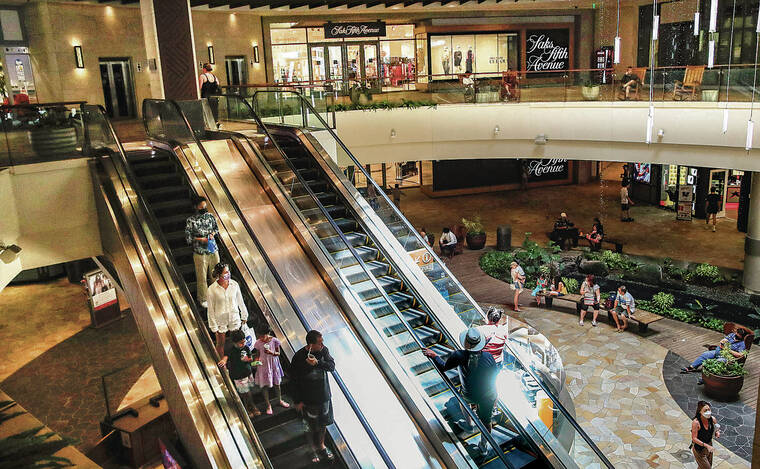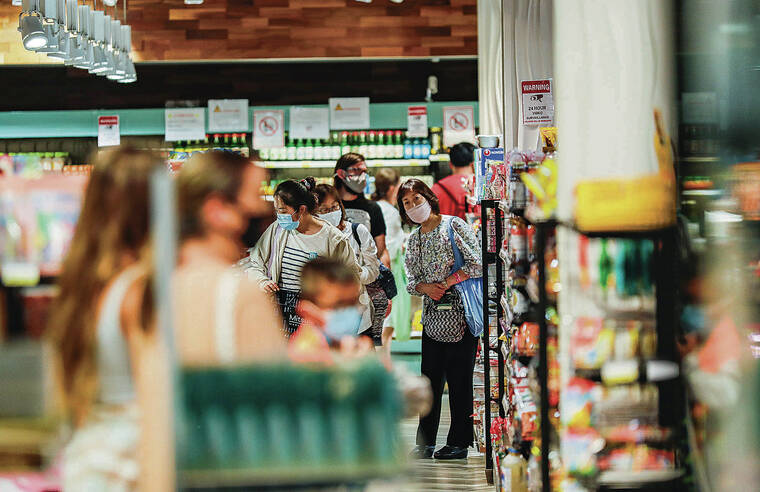The face masks are coming off after 11:59 p.m. today, when Hawaii lifts its indoor mask mandate — but not everywhere.
Starting at midnight, Hawaii drops two remaining restrictions that have been in place in response to the COVID-19 pandemic for the past two years: its indoor mask mandate and Safe Travels program.
Residents waking up Saturday morning will no longer be required to wear face masks indoors at many public places, including the Hawai‘i Convention Center, most grocery stores, movie theaters and gyms, and the common areas of shopping centers and malls.
Instead, masks will be optional at many of these venues.
Domestic travelers Saturday can arrive at airports freely without registering, showing proof of vaccinations or negative tests to bypass a five-day quarantine no longer required.
Gov. David Ige announced earlier this month that both would sunset along with the current emergency proclamation for the COVID- 19 pandemic at 11:59 p.m. today.
Many of Oahu’s major shopping centers, including Ala Moana Center and Pearlridge Center, said beginning Saturday, masks will no longer be required in common areas indoors but that individual stores and restaurants could set their own rules.
Ala Moana recommends that customers have a mask handy just in case, or check with the businesses directly ahead of time.
Reactions from the public were mixed, with some more than ready to ditch their masks and return to a sense of normalcy, while others plan to continue wearing their masks anyway due to the presence of the more contagious BA.2 omicron subvariant in the isles.
Summer Caster of Kailua said she’s looking forward to venturing indoors without a mask after two long years, and that she feels comfortable with it since she is vaccinated and boosted.
“It’ll be nice,” she said. “I feel like it’s a step forward.”
Dorothy Latham of Ala Moana said she will continue masking for a few more weeks while observing case trends.
“I’m fully vaccinated, but I think to protect yourself, you need to do what you need to do,” she said.
Having been raised in Japan, where masks are a normal part of life, it’s not a big deal for her to wear one.
Jan Hayashi of Honolulu plans to continue masking whenever indoors, other than at home or in her car.
“I turned 65 this year and my boyfriend is 76, so wearing a mask is to protect both of us from people who may be asymptomatic,” said Hayashi. “I deal with the public at my workplace, so I don’t want to bring anything home that could affect my boyfriend’s health. I just don’t think we are over this, but the numbers will tell.”
The right time
Lt. Gov. Josh Green said now is the “right time” to lift these two remaining restrictions in Hawaii, based on U.S. Centers for Disease Control and Prevention guidelines and encouraging statistics.
“It’s the right time based on the science, because we have so few people in the hospital and so few people sick,” said Green, who will not require masks at his own office, where staff are vaccinated and boosted. “We’ll continue to follow the science with the CDC if there’s a surge of a subvariant or another concern. But following the science has worked for us. It’s ending what it needed to end.”
On Wednesday the state Department of Health reported 827 more infections statewide compared with the previous week, bringing Hawaii’s total since the start of the pandemic to 239,591 cases. Five more deaths were reported, bringing the state’s COVID-19 death toll to 1,373.
The positivity rate ticked up slightly to 2.9% Wednesday, compared with 2.3% the previous Wednesday.
Hospitalizations of patients with COVID-19 dropped to 26 Wednesday, according to the state dashboard — a low it has not reached since mid-June, prior to the delta surge.
Green said based on his own data, hospitalizations remained in the 20s range the entire week.
On Thursday he tallied only 20 patients with COVID- 19 at hospitals, which he said was a 95% drop from the peak of hospitalizations at 383 during the omicron surge in late January.
He said it was time to end Safe Travels, a program that helped screen more than 11 million passengers traveling to Hawaii to prevent the spread of the coronavirus.
Safe Travels began in October 2020 as a pre-travel testing program allowing incoming travelers to bypass a 14-day quarantine with a negative COVID-19 test. In its latest iteration, domestic travelers with proof of vaccination or a negative test within 72 hours prior to departure to Hawaii could bypass a five-day quarantine.
Hawaii was the only U.S. state with a program of this kind in place, according to Green.
“I’m convinced that’s one of the reasons we have the lowest infection rate in the country and the second- lowest death rate,” he said, “and it made it possible for our economy to recover, too.”
At 2 a.m. Saturday the Safe Travels digital platform at travel.hawaii.gov Opens in a new tab will be taken down, along with the Hawaii SMART Health Card application.
More than 272,00 SMART Health Cards were downloaded up to this week. The Safe Travels web application will be retained in case there is a need to restart the program, according to Chief Information Officer Doug Murdock, state Office of Enterprise Technology Services.
Masks still required
Masks are still required indoors at public schools and hospitals in Hawaii, and on public transit, including commercial planes, buses, and at airports.
Under federal rules, riders will still need to wear masks at all times while aboard TheBus and TheHandi-Van on Oahu after today.
The Transportation Security Administration has extended its directive requiring masks on public transportation and in transportation hubs nationwide through April 18.
Hawaii Theatre also intends to keep mask and vaccine-or-test requirements in place beyond today.
President Gregory Dunn said Hawaii Theatre is following the lead of the Broadway League, a consortium of 41 theaters that will maintain masking and vaccination requirements through April 28. The theater is also accepting patrons with negative COVID-19 tests.
“They are asking us in the industry to be responsible and to enact safety requirements to help keep the community safe,” he said. “If we don’t manage it, there would be further restrictions that could come down.”
After two years of closure and $6 million in losses, the theater can’t afford for that to happen, he said, and so far, patrons have been overwhelmingly supportive.
The Chamber of Commerce Hawaii, in a recent survey of about 400 members, found that nearly half, mostly those in professional, scientific and technical services, planned to keep masks at their workplaces.
Health experts, meanwhile, are keeping an eye on the more contagious BA.2 subvariant of omicron, which now makes up 13% of COVID-19 cases in Hawaii and 35% of cases circulating in the U.S.
Tim Brown, epidemiologist at the East-West Center in Manoa, said he would strongly recommend that people keep masking indoors until there’s a better sense of how BA.2 will affect Hawaii.
He is concerned about waning immunity in the population, particularly since only 38% of the state has been boosted, meaning many remain susceptible to omicron infections.
Also, he said the Health Department should offer daily rather than weekly updates on coronavirus cases along with wastewater results to keep the public informed of COVID-19 risk levels, especially if the state is shifting decision-making to individuals.
“The fundamental issue we face right now is there is real fatigue with this,” he said. “People are tired of COVID, but that doesn’t make COVID any less dangerous going forward. When we’re asking people to make their own choices about safety, then it’s really critical that they have accurate information on which to base those choices.”
Otherwise, Brown said, “we’re pretty much flying blind into this.”
Those who are immunocompromised, seniors or under age 5 — and the economically disadvantaged — remain the most vulnerable as restrictions are lifted, he said.
Ige on Thursday signed a new emergency proclamation extending the availability of Supplemental Nutrition Assistance Program benefits to local families another two months, and said he had no intentions of implementing further pandemic-related proclamations.




